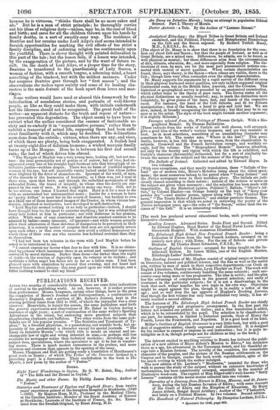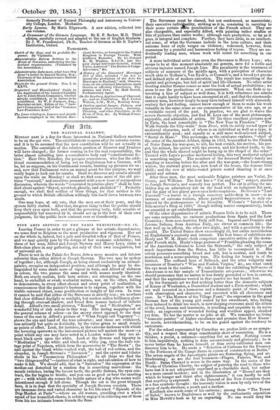PUBLICATIONS RECEIVED.
Arrmi two months of considerable flatness, there are some faint indications of revival in the publishing world. As yet, however, it is rather promise than performance. Messrs. Longman, among other things, have in the press the completion of Moore's Journal and Correspondence, a continuation of Macaulay's England, and a portion of Mr. Raikes's Journal, kept in the stirring political times from 1831 to 1847, of which the journalist was a close observer. Meanwhile, to herald the season, the same publishers send forth the general experiences and observations of Mr. Baker in Ceylon during a residence of eight years ; a sort of continuation of the same writer's Sporting Adventures in the island, but embracing more practical subjects than slaughtering elephants and buffaloes. Two other works from the same pub- lishers are of less popular promise. " The Statistics and Treatment of Ty- phus," by a Swedish physician, is a painstaking and sensible book, but ap- parently of too professional a character except for special journals. " The Essay on Intuitive Morals,"—by which title is meant an eternal and un- changeable law of right and wrong inherent in man,—is perhaps still less available for newspaper notice than technical medicine ; involving, as the subject does, geculations, where the speculator is apt to be lost in wander- ing mazes. There is much modest earnestness in the preface, and more clearness and closeness than appears in the opening of the essay. Messrs. Chapman and Hall are getting ready a translation of Hasthausen's great work on Russia ; of which The Tribes of the Caucasus (noticed in a preceding page) is a forerunner. Their contribution to the week is The Mystic, a new poem by the author of " Festus."
Books.
Eight Years' Wanderings in Ceylon. By S. W. Baker, Esq., Author of " The Rifle and the Hound in Ceylon."
The Mystic and other Poems. By Phillip James Bailey, Author of " Festus."
Statistic* and Treatment of Typhus and Typhoid Fever; from twelve years' experience gained at the Seraphim Hospital in Stockholm, (1840 —1852). By Magnus Huss, M.D., 'Professor in the Medical Clinic, at the Caroline Institute ; Member of the Royal Academy of Science at Stockholm ; laureate of the Institute of France, &c. &c. Trans- lated from the Swedish Original, by Ernst Aberg, M.D. An Essay on Intuitive Morals; being an attempt to popularize Ethical Science. Part I. Theory of Morals.
Doctor Antonio : a Tale. By the Author of "Lorenzo Benoni."
Analytical Ethnology : the Mixed Tribes in Great Britain and Ireland examined, and the Political, Physical, and Metaphysical Blunderiegs on the Celt and the Saxon exposed. By Richard Tuthill Massy, M.D., L.R.C.S.I., &c. &o.
[The object of Dr. Massy is to show that there is no foundation for the com- mon cry about Celt and Saxon ; but that the people of Ireland, as well as of Great Britain, are a mixed race. Differences, he admits, are to be found, as well physical as mental ; but those differences arise from the circumstances of diet, climate, education, &c., and more especially from religion. The dis- tinctions of race, he says, are for the most part preconceived notions con- nected with mental or moral qualities. When certain characteristics are found, there, says theory, is the Saxon—when others are visible, there is the Celt ; though facts very often contradict even the alleged characteristics.
Dr. Massy supports his arguments by a rapid survey of the different races in their physical traits and social qualities, not only in,their supposed original Continental seats, but in the British Isles, America, and the Colonies. This historical or geographical survey is preceded by an anatomical examination, which rather leans to the theory of pure races. The Doctor states all the physical distinctions as usually received; nay, to mark the distinction more completely, he gives plates of the faces, feet, and hands of the respective races. For instance, the hand of the Celt delicate, and fit for delicate manipulation ; that of the Saxon, a hand to grip and hold fast. We are slow, indeed, at broadly recognizing the distinction ; but that may be in our eyes or in the artist. The style of the book might furnish another argument.; it is slightly Milesian.] Passages selected from the Writings of Thomas Carlyle. With a Bio- graphical Memoir. By Thomas Ballantyne. [These extracts from the works of Carlyle are well chosen, well arranged, give a good idea of the writer's various manners, and are very readable to boot. As in most selections, something of an unsatisfying character may sometimes be felt The reader asks, " Where is the rest ?" This pecu- liarity, however, is less felt than in many cases, from the classification by subjects. Cromwell and the French Revolution occupy, and worthily oc- cupy, half the volume. The "Biographical Memoir " deserves attention, not only for the brevity and vigour with which the life is exhibited, and Carlyle 's character (favourably) delineated, but for a sort of similarity be- tween the nature of the subject and the manner of the biography.] The Ballads of Ireland. Collected and edited by Edward Hayes. In two volumes.
[With rare exceptions, and they mostly translations, these "Ballads of Ire- land " are of modern date, Moore's Melodies being about the oldest speci- mens ; the most numerous belong to the period when "Young Ireland' and the Nation newspaper were in their meridian glory. The ballads are judi- ciously classed according to their nature ; notices of the writers or notes on the subject are given when necessary ; and the selection has been made with impartiality. In the Historical [qusere, Political?] Ballads, "Oliver's Ad- vice," by colonel Blacker—an Orange homily on the text of "Keep your powder dri"—and similar poems, appear along with "The Wexford Mas- sacre," "The Treaty Stone of Limerick," and similar patriotic themes. The general impression is that which we noted in reviewing the poetry of the Nation newspaper years ago—the echo of " the Saxon," rather than the ra- ciness of " the Celt." It is an interesting collection.]
[The week has produced several educational books, each possessing some distinctive character.
Reading Lessons. Advanced Series. Books First and Second. Edited by Edward Hughes, Head Master of the Royal Naval Lower School, Greenwich Hospital. With numerous Illustrations.
The Edinburgh High School New Practical French Reader: being a Collection of Pieces from the beat French Authors, arranged on an entirely new plan; Notes. For the use of Schools and private Students. By Charles Henri Schneider, F.E.I.S., &c.
Outlines of English Grammar : arranged for being taught on the In- tellectual System. By James Millar, one of the English Masters, Edinburgh ladies Institution.
The Reading Lessons of Mr. Hughes consist of original essays or treatises on literature, natural and political science, and the fine as well as the useful arts, written by men of mark in their respective departments,—as Craik on English Literature, Chorley on Music, Lyon Playfair on Food. The work will consist of five volumes, continuously handling the same subjects ; each suc- cessive essay being more or leas progressive. The idea is novel ; and the plan has the advantage of completeness in the general selection, and unity of treatment in the particular subjects ; for it is not a disadvantage to the book that each writer handles his own topic in his own way. Objections might be urged against the plan, though it is in reality a reflex of the age ; and so well does the age approve of Hughes's Reading Lessons, that though the first volume has only been published very lately, it has al- ready reached a second edition.
The features of The Edinburgh High School French Reader are chiefly those of typography and progressive arrangement In the first part the letters not sounded are printed in italics; and a free translation is added, which is to be retranslated by the pupil. The selection is by classification : one part, for instance, is limited to historical periods, those of Henry the Fourth, Louis the Fourteenth, and Napoleon. It is a good book of its kind. Millar's Outlines of English Grammar is a very little book, but with a good deal of suggestive matter, clearly expressed and illustrated. It is designed for the teacher to expand or impress in oral instruction ; but it is quite in- telligible as it is, though perhaps not for children as tiny as the book.] The interest excited in anything relating to Russia has induced the publi- cation of a new edition of Major Abbott's Mission to Shiva,* his detention there as a spy, his adventures in the Turcoman desert, and Ids thankful es- cape into a Russian fortress. The novelty of the countries, the remarkable character of the peoples, and the picture of the Russian settlements on the Caspian and in Georgia, render the book worth republication, spite of the too much writing in which the author indulged.
The new edition of Dr. Lardner's " Mechanics," intended for those who wish to pursue the study of the subject without an extensive knowledge of mathematics, has been considerably enlarged, especially in the number of illustrative wood-cuts. The reprint of Miss Edgeworth's well-known "Early Lessons " contains all the moral stories collected into one volume.
Narrative of a Tourney from Heraut to Shiva, Moscow, and St. Peters- burg, during the late Russian Invasion of Nh'Iva • with some Account of the Court of Khiva and the Kingdom of Khaurism. By Major James Abbott, Bengal Royal Artillery; Author of the " T'hakooine," and lately on a Political Mission. In two volumes. Second edition. The Handbook of Natural Philosophy. By Dionyaiva Lardner, D.C.L ;
• Spectator for ISO, page 665. formerly Professor of Natural Philosophy and Astronomy in Univer- sity College, London. Mechanics.
Early Lessons. By Maria Edgeworth. A new edition, collected into one volume.
A Grammar of the German Language. By K. F. Becker, M.D. Third
edition, carefully revised and adapted to the use of lish Students. By J. W. Fraedersdorf, Ph.D., Teacher of German at it B. Taylor's Institution, Oxford.
PAMPHLETS.
Sketch of the Siege and its probable Se- gue:we. By Vigilantia.
Administrative Reform Petition to the House of Commons, embodying the im- mediate requirements. (Published by the Association.)
Administrative Reformers, what have they Done/ a Letter to Samuel Morley, Esq., Chairman of the Administrative Reform Association.
71-acts for the present Crisis. Nos. I. to XXVI.
Projectors' and Shareholders' Guide to the Application of the Limited Liability Act to Joint-Stock Companies, whether already established, or in future to be established. By W. F. Finlason, Esq., Barrister-at-law, Editor of the " Law- yer's Companion," and of the "Common Law Procedure Acts."
The Laws relating to Lascars and Asiatic Seamen employed in the British Mer- chant Service, or brought to the United Kingdom in Foreign Vessels. With prefatory Remarks. By Lt.-Colonel It. M. Hughes, E.I.C.S., late De- puty Judge-Advocate-General, Scinde Force; Author of " The Duties of J udge- Advocates," fk.c.
I History of the Dissenters' Marriages Rill of 1555, intituled " An Act to amend the provisions of the Acts for Marriages in England," with Observa- tions on the principal Alterations made therein as affecting Churchmen, Dis- senters, and Jews. By Hull Terrell, Parliamentary Agent.
On the Sanitasw Applkationsof Charcoal, 4v., and on Ventilation. By J. Forbes 'Watson, A.M., M.D., Bombay Army.
A Caution against Images, Pictures, and Superstitious Decorations, Intoning, Chanting, and other Frivolities, in the House of God, &c. By William Peace, a Layman.



































 Previous page
Previous page